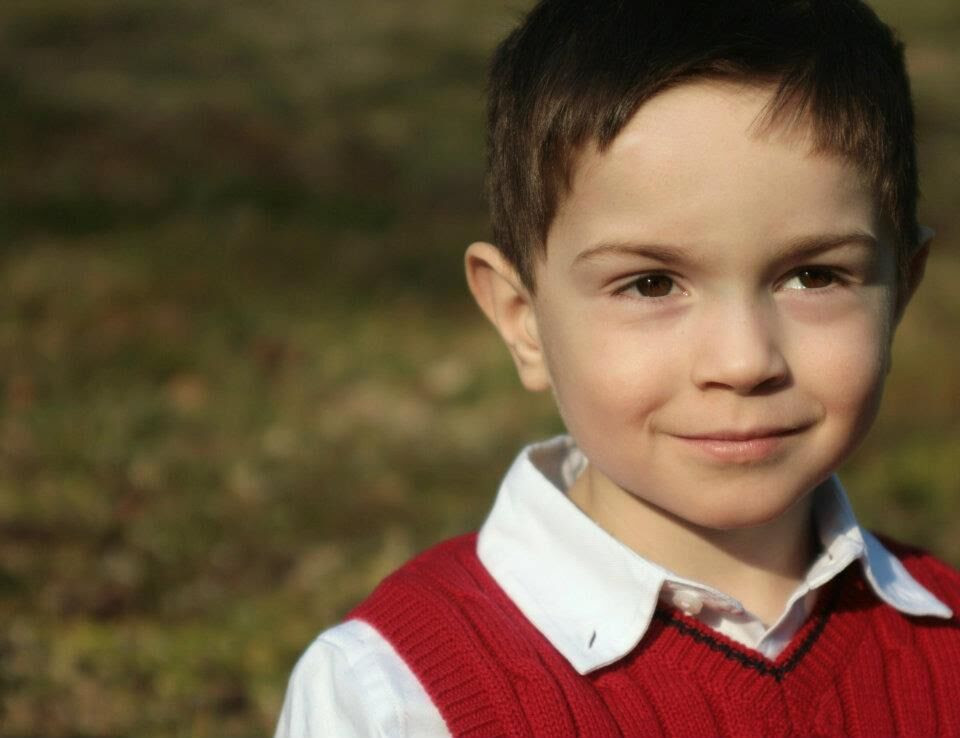
November is recognized as National Marrow Awareness Month in order to raise public consciousness of the nearly 10,000 U.S. patients who are waiting for a life-saving bone marrow transplant. For one Connecticut family, this month of gratitude will include an expanded Thanksgiving table thanks to a non-related bone marrow donor who gave their son a second chance at life.
Milledge Estes was born in September 2007, and Mom Melanie, is quick to admit that before Milledge was born, she had never heard of Diamond Blackfan Anemia. But she quickly became an expert when her newborn son was diagnosed with this rare disease at only six weeks old. Now with Milledge being post-transplant and starting to live life to the fullest, Melanie looked back and wrote a poignant narrative about that very different, upside down time in their lives.
Before Milledge was born, we had never heard of Diamond Blackfan Anemia (DBA). A doctor noticed Milledge was pale at birth. Though he was full term and my pregnancy uneventful, he was immediately transferred to the NICU where he received his first blood transfusion as I laid in recovery. Five days later, we found ourselves meeting with a hematologist at the Children’s Hospital of Philadelphia (CHOP); and at six weeks old after many more blood transfusions, Milledge was diagnosed and we joined a community of less than 1,000 families whose children have DBA.
DBA is a rare condition in which the bone marrow does not produce red blood cells, and because of that, Milledge needed a blood transfusion every two to three weeks to survive. Unfortunately, a side effect of red cell transfusions — iron overload — can cause iron from those transfusions to build up in the body and lead to organ failure. Milledge struggled more with this side effect than was expected. We treated his iron overload with a drug called Desferal, which required a needle stick every night and for him to be hooked to a pump for 12 hours. Knowing that blood transfusions may not be a sustainable treatment in the long term, we also trialed other treatments, but each trial failed.
In the winter of 2014, we met with Milledge’s doctors, gathered second opinions and made the difficult decision to pursue a bone marrow transplant at CHOP. From there we undertook the difficult task of preparing for a transplant. We lived just outside of the zone in which we could immediately return home after discharge, so we knew we needed to be ready to live in Philadelphia for a few months. With little time, we quickly planned to turn our lives upside down, and Milledge, especially, tried to make peace with the idea that we would need to leave our support system behind to, as he phrased it, “live in hospitals.”
In February 2015, Melanie reached out to the Children’s Organ Transplant Association (COTA) based on the recommendation by a COTA mom whose son had the same diagnosis as Milledge and had already had his bone marrow transplant. COTA uniquely understands that parents who care for a child or young adult before, during and after a life-saving transplant have enough to deal with, so COTA’s model shifts the responsibility for fundraising to a community team of trained volunteers. COTA is a 501(c)3 charity so all contributions to COTA in honor of Milledge E are tax deductible to the fullest extent of the law, and these COTA funds are available for his lifetime.
COTA sent a fundraising specialist to the family’s hometown in mid-March to train the volunteers. The COTA team of volunteers quickly got to work organizing fundraisers to raise funds for transplant-related expenses.
On April 14, 2015, Milledge was admitted to CHOP for the transplant. A few weeks before admission, we had been presented with Milledge’s roadmap outlining his conditioning regimen that consisted of high doses of chemotherapy to destroy his existing bone marrow, or, in the words of his oncologist, “clear out space to make room for the new stem cells and suppress his immune system to prevent rejection.” Over 10 days, we watched Milledge suffer the effects of the chemotherapy, and we also witnessed his counts drop. While we were able to give him red cell and platelet transfusions, his white cell counts became smaller and smaller. One of the doctors that week talked about the difficulty parents have in reconciling the desire to see those numbers shrink to zero (that means the chemo is working!) while also coping with the terror that comes when one’s child is left without an immune system, defenseless against something as benign as a common cold.
Milledge also struggled during this time, as he, only seven years old, had not truly appreciated what isolation would be like. At CHOP, children are not allowed to be together in the play room, so most of his interaction was with adults who were all wearing gowns and mask. Additionally, the effects of chemotherapy hit him hard. Though most people marveled at how well he had handled seven years of transfusions and frequent hospital visits … to him that was normal. It was not until transplant that he saw himself as sick, and during a bout of fever and nausea, he asked for the first time if he might die.
But transplant has a way of pushing you forward, even when you would like to stay where you are. The day his cells arrived, he was in good spirits and feeling well. In fact, he felt amazing for a few days following transplant until he developed mucositis, an inevitable but painful side effect of chemotherapy that causes throat and GI pain as well as vomiting. What we were not prepared for was Milledge’s development of Veno-Occlusive Disease, in which the small veins of the liver become occluded, causing a backup of fluid. We watched as Milledge’s belly became distended, his face puffy, and his liver and kidney struggled to do their jobs. Milledge was placed on an investigational drug and a peritoneal drain was placed to remove excess fluid. What was most difficult, though, was seeing how much pain Milledge was experiencing. For a few days, he spent hours crying, stopping only to sleep for a half hour, waking up again begging for help. Preparing for the worst, the idea that his final days might be spent in such a state haunted us, but once the drain was placed, each day seemed a bit better than the last.
Milledge made a full recovery and he was eventually discharged to a nearby hotel where we stayed until finally being allowed to go home. Still in isolation, our return to our house was an amazing experience and we were even able to watch my younger brother, Milledge’s Uncle Alex, get married via Skype on our own couch!
We are over two years out now and the past months seem surreal. I recently talked to a friend whose child is currently about four months out from a transplant, and we each discussed the common advice that is given to parents in which we are told to prepare to lose a year to the transplant process. In a way, that’s true. Milledge returned to school after a year’s absence and I have not had a normal life since before this process started. Still, the idea that the year is just lost or gone does not give justice to the difficulty of the experience. Transplant is not a situation in which we went to sleep in April of 2015 and woke up a year later. Instead, we spent a year isolated from friends and family, worried sick over symptoms and germs, and forced to create a new life, indoors and away from others. Instead of losing a year, it was as if Milledge had a year trapped inside — whether that be in a hospital room, hotel, or home — while he also saw glimpses of the outside world he was not able to experience. When he finally returned to school, he came home, anxious about the fun his peers told him he missed. He didn’t simply miss a year; he was forced to watch everyone else’s year pass by.
Still, Milledge’s transplant story is one of triumph and community — even if that community was far away. We live in a world in which people often complain about the loss of traditional community and the negative impact modernity and technology have on our collective values. That has not been my experience. When I told my friends Milledge needed a bone marrow transplant and explained the incredible impact it would have on our family and finances, they rallied around us and, with the help of COTA, ensured that we would not feel financial stress while trying to cope with emotional worries. We witnessed both good friends and people we had never met join together to lift prayers for our family and raise funds for transplant-related expenses. To this day I still meet people who, when I introduce Milledge, ask if he is Mighty Milledge, the boy who had a bone marrow transplant. They did not know us, but they followed his story and rooted for him in good times and bad.
One of the unexpected things COTA’s support and resources did for us was to provide our fundraising team with the capacity to help us beyond a financial level. By building a pool of contributors and supporters, I had hundreds of friends, families, and strangers who offered assistance when we needed it. One of those moments came when Milledge was suffering from Veno-Occlusive Disease. I had taken a much needed break from social media, as I did not have the emotional reserves to cope with anything more than what was happening in our hospital room. During that time a friend texted and told me people were requesting an update on Milledge. When I opened Facebook, I saw that a woman from my Crossfit gym had created and ordered Mighty Milledge temporary tattoos. My newsfeed was full of people wearing them and posting pictures to show their support.
More than the money raised, the efforts of our COTA fundraising network reminded me that we were not alone and that we had hundreds of people who stood behind us. On a day in which I did not know if my son would live or die, I saw that no matter what happened we would face future challenges with the strength of our community. COTA helped us build that community, and while I will be eternally grateful that I did not need to reach into our retirement savings to pay our hotel or hospital bills, the real impact COTA had on our lives extended far beyond our finances. COTA laid a foundation that provided us with hope and comfort on our most difficult days.
Today, 10-year-old Milledge is back to his happy and energetic self. He is finally able to enjoy a normal life with fewer visits to the hospital. If you ask Milledge what he wants to be when he grows up he is quick to tell you four things: a pop superstar, an actor, a paleontologist and a doctor. According to Mom Melanie, he is ambitious!
In just a few weeks, the family’s Thanksgiving table will be full of grateful people and will likely include a place of honor for Milledge’s bone marrow donor for whom they are forever grateful.





